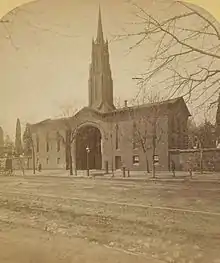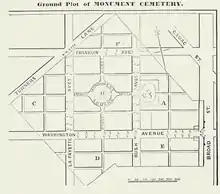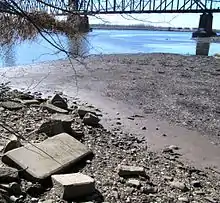Monument Cemetery
Monument Cemetery was a rural cemetery located in Philadelphia, Pennsylvania from 1839 to 1956. The land is now part of the campus of Temple University.
 Gothic gatehouse to Philadelphia's Monument Cemetery circa 1868. It was torn down in 1904 to extend Berks Street. | |
| Details | |
|---|---|
| Established | ~1837-39 |
| Location | |
| Country | United States |
| Type | private |
| Find a Grave | Monument Cemetery |

History
The cemetery design was laid out in 1836 and 1837 by Dr. John A. Elkinton. The lot holders were incorporated on March 19, 1838 as the Monument Cemetery Company of Philadelphia.[1] It was second garden or rural cemetery in Philadelphia, after Laurel Hill Cemetery, and was based on Père Lachaise Cemetery in Paris.[2] It was located near Broad and Berks streets.[3]
Though originally intended to be called "Pere La Chaise",[4] it was soon renamed Monument Cemetery, based on a plan to include a central obelisk dedicated to George Washington and Marquis Lafayette. Designed by John Sartain,[5] the obelisk was not actually dedicated until 1869.[6] One notable monument was created for William De La Mater Caldwell, who left $3,000 in his estate for that purpose.[6][7]
Legacy
Burials stopped by the late 1920s, and the cemetery was in disrepair by the early 1950s. Temple was eventually able to acquire the land, which it wanted for use as a parking lot and athletic fields. After families claimed about 8,000 of the 28,000 bodies on the site, the rest of the remains were placed in an unmarked grave at Lawnview Memorial Park.[2][8][9]

Many of the remaining headstones from the cemetery were used as riprap for the Betsy Ross Bridge, some of which can be still be seen at low tide.[2][3]
Notable burials
An incomplete list of burials at the former Monument Cemetery includes:
- DeWitt Clinton Baxter, Brigadier general, American Civil War
- John Hull Campbell, served in U.S. Congress 1845-47
- Russell Conwell, founder of Temple University[9]
- Thomas Birch Florence, served in U.S. Congress 1851-61
- Bill Fouser (1855-1919), professional baseball player
- Nathan Bishop Jennings, Captain, Revolutionary War[10]
- James Landy, served in U.S. Congress 1857-59
- Henry Dunning Moore, served in U.S. Congress 1849-53
- John Sartain, artist
- Hampton S. Thomas, U.S. Medal of Honor Winner (American Civil War)
References
- Scharf, John Thomas (1884). History of Philadelphia, 1609-1884. Philadelphia: L.H. Everts & Co. p. 2359. Retrieved 23 August 2019.
moriah.
- Barley, Luke (28 June 2012). How Thousands of Headstones Ended Up Under a Philadelphia Bridge, City Lab
- Geringer, Dan (21 December 2012). It's R.I.P. tide along the Delaware River, Philadelphia Inquirer
- Bowen, Daniel. A History of Philadelphia, pp. 102-110 (1839)
- Keels, Thomas H. Philadelphia Graveyards and Cemeteries (2003)
- Westcott, Thompson. The Official Guide Book to Philadelphia, pp. 310-11 (1876)
- (31 January 1843). 1843 advertisement, Public Ledger
- (3 January 1957). Defunct Cemetery Asks Remission of Old Lien, Philadelphia Inquirer
- Puckett, John L. & Mark Frazier Lloyd. Becoming Penn: The Pragmatic American University, 1950-2000, p. 345 (2015)
- "Nathan Bishop "Elnathan" Jennings". www.findagrave.com. Retrieved 25 August 2019.